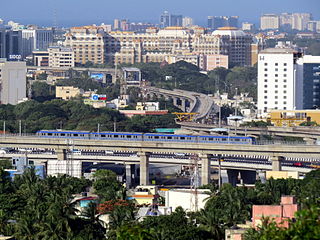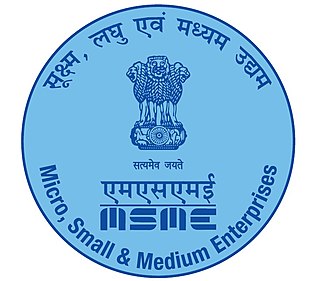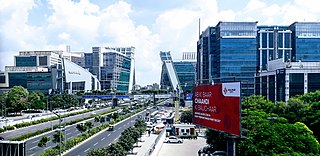
Rupee is the common name for the currencies of India, Mauritius, Nepal, Pakistan, Seychelles, and Sri Lanka, and of former currencies of Afghanistan, Bahrain, Kuwait, Oman, the United Arab Emirates, British East Africa, Burma, German East Africa, and Tibet. In Indonesia and the Maldives, the unit of currency is known as rupiah and rufiyaa respectively, cognates of the word rupee.
Small and medium-sized enterprises (SMEs) or small and medium-sized businesses (SMBs) are businesses whose personnel and revenue numbers fall below certain limits. The abbreviation "SME" is used by international organizations such as the World Bank, the OECD, European Union, the United Nations, and the World Trade Organization (WTO).

The Khadi and Village Industries Commission (KVIC) is a statutory body formed in April 1957 by the Government of India, under the Act of Parliament, 'Khadi and Village Industries Commission Act of 1956'. It is an apex organisation under the Ministry of Micro, Small and Medium Enterprises, with regard to khadi and village industries within India, which seeks to - "plan, promote, facilitate, organise and assist in the establishment and development of khadi and village industries in the rural areas in coordination with other agencies engaged in rural development wherever necessary.".
Electronics Manufacturing Services (EMS) is a term used for companies that design, manufacture, test, distribute, and provide return/repair services for electronic components and assemblies for original equipment manufacturers (OEMs). The concept is also referred to as Electronics Contract Manufacturing (ECM).

Tamil Nadu has the second largest state economy in India. It is also the most industrialised state in the country. The state is 48.40% urbanised, accounting for around 9.26% of the urban population in the country, while the state as a whole accounted for 5.96% of India's total population in the 2011 census. Services contributes to 54% to the gross domestic product of the state, followed by manufacturing at 33% and agriculture at 13%.

The Ministry of Micro, Small and Medium Enterprises is the ministry in the Government of India. It is the apex executive body for the formulation and administration of rules, regulations and laws relating to micro, small and medium enterprises in India. The Minister of Micro, Small and Medium Enterprises is Narayan Rane.

The economy of Bihar is one of the fastest-growing in India. It is largely service-based, with a significant share of agricultural and industrial sectors. The GDP of the state was ₹7,45,310 crores at the current market price (2022–23).

The Economy of Madhya Pradesh refers to the economic growth with respect to the Indian state of Madhya Pradesh. It grew 12% in GDP for the year of 2011–12, for which it received an award from the President Pranab Mukherjee in January 2013 for improving its tourism, medical and infrastructural growth. The economy of Madhya Pradesh is significantly agrarian which is reflecting rapid strides towards industrial and service sectors as well. The Indore, Bhopal and Jabalpur districts are the top 3 districts in terms of highest output generation in the state's economy.

GSDP of Haryana state is estimated to be US$140 billion in 2023-2034 which had grown at 12.96% CAGR between 2012–17, boosted by the fact that this state on DMIC in NCR contributes 7% of India's agricultural exports and 60% of India's Basmati rice export, with 7 operational SEZs and additional 23 formally approved SEZs. Haryana also produces India's 67% of passenger cars, 60% of motorcycles, 50% of tractors and 50% of the refrigerators, which places Haryana on 14th place on the list of Indian states and union territories by GDP behind only much bigger states that are significantly larger in both area and population.

The Civil Liability for Nuclear Damage Act, 2010 or Nuclear Liability Act is a highly debated and controversial Act which was passed by both houses of Indian parliament. The Act aims to provide a civil liability for nuclear damage and prompt compensation to the victims of a nuclear incident through a no-fault liability to the operator, appointment of Claims Commissioner, establishment of Nuclear Damage Claims Commission and for matters connected therewith or incidental thereto.
Central Tool Room and Training Centre, located in Bhubaneswar, is an autonomous body under the Ministry of Micro, Small and Medium Enterprises, Government of India. In addition to imparting technical training for the skill development of technical staff as well as students in the engineering and technical fields, the institute strives to foster the progress of micro, small and medium enterprises in the country and to facilitate the development of the youth.
The Federation of Indian Micro and Small & Medium Enterprises (FISME) is an Indian NGO that is the progressive face of Indian MSMEs and is regarded as such by the Government of India. It is a member of the National MSME Board formed under the MSME Act 2006. FISME is consulted by SME policy making set-up of the country and also works in close coordination with the Ministry of Micro, Small & Medium Enterprises as well as major multilateral and bilateral bodies in India such as UNIDO, ILO, UNCTAD, DFID, GTZ etc. Supported by UNCTAD, DFID and Ministry of Commerce & Industry, as a Tier-I partner, FISME is leading 22 provincial SME bodies in 18 states.

Andhra Pragathi Grameena Bank is a Regional Rural Bank in India. It was established in 2006 as a Scheduled Commercial Bank as per Regional Rural Banks Act of 1976 to provide banking facilities in Ananthapuram, Kadapa, Kurnool, Nellore and Prakasam districts of Andhra Pradesh. It is under the ownership of Ministry of Finance, Government of India

National Small Industries Corporation Limited (NSIC) is a Mini Ratna government agency established by the Ministry of Micro, Small and Medium Enterprises, Government of India in 1955 It falls under Ministry of Micro, Small & Medium Enterprises of India. NSIC is the nodal office for several schemes of Ministry of MSME such as Performance & Credit Rating, Single Point Registration, MSME Databank, National SC ST Hub, etc.

The Nepalese Ministry of Minister of Industry, Commerce and Supplies is a governmental body of Nepal to monitor and manage industries of the country.
Micro Units Development and Refinance Agency Bank ) is a public sector financial institution in India. It provides loans at low rates to micro-finance institutions and non-banking financial institutions which then provide credit to MSMEs. It was launched by Prime Minister Narendra Modi on 8 April 2015.

Stand-Up India was launched by the Government of India on 5 April 2016 to support entrepreneurship among women and SC & ST communities. Stand Up India Loan Scheme is a government initiative launched by the Government of India in 2016 to promote entrepreneurship and facilitate bank loans to Scheduled Caste (SC) / Scheduled Tribe (ST) and women entrepreneurs in the country. The scheme aims to provide loans between Rs.10 lakhs and Rs.1 crore for setting up a greenfield enterprise in manufacturing, trading or services sector.
The Indian electronics industry saw growth in the early years of the 21st century, encouraged both by government policies and incentives and by international investment. Its key and most resource-intensive segment, the semiconductor industry, was benefitted from domestic demand growing briskly. Semiconductors were required by a large number of industries, including telecommunications, information technology, industrial machinery and automation, medical electronics, automobile, engineering, power and solar photovoltaic, defence and aerospace, consumer electronics, and appliances. As of 2015, however, the skill gap in the Indian industry threatened progress, with 65 to 70 percent of the market relying on imports.

Ministry of Communications is a Central ministry under the Government of India responsible for telecommunications and postal service. It was carved out of Ministry of Communications and Information Technology on 19 July 2016.













